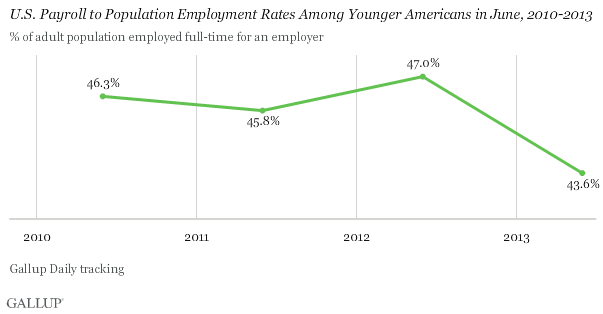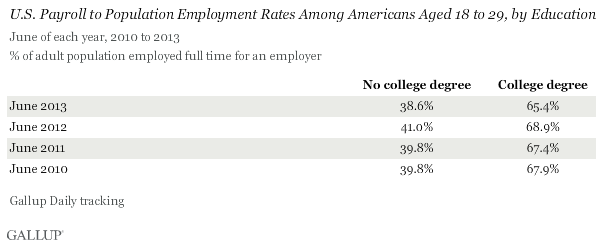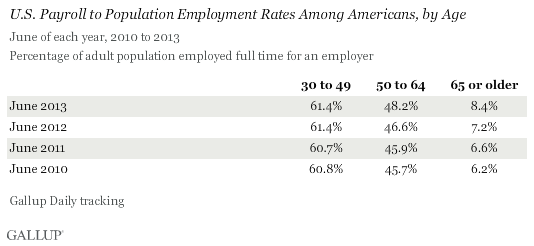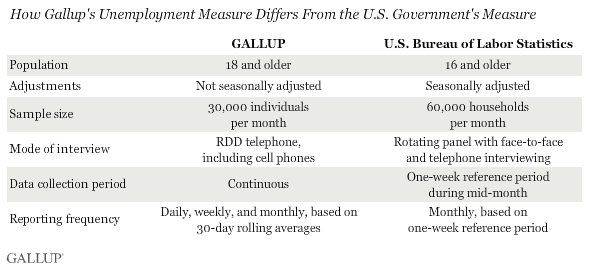WASHINGTON, D.C. -- Fewer Americans aged 18 to 29 worked full time for an employer in June 2013 (43.6%) than did so in June 2012 (47.0%), according to Gallup's Payroll to Population employment rate. The P2P rate for young adults is also down from 45.8% in June 2011 and 46.3% in June 2010.

These results are based on Gallup Daily tracking interviews, conducted by landline and cellphone, with approximately 30,000 Americans each month. Gallup's P2P rate measures the percentage of the U.S. adult population that is employed full time by an employer for at least 30 hours per week. Gallup does not seasonally adjust P2P, so same-month comparisons from year to year provide the best insight into how the trend is changing over time.
Younger Americans Less Likely to Have Full-Time Work Now, Regardless of Education
Currently, Americans aged 18 to 29 who have at least a college degree are nearly twice as likely (65.4%) as their counterparts without a degree (38.6%) to have a full-time job. This difference likely reflects the benefits of a college education in today's job market. However, it is also likely that some young adults without a degree are not looking for full-time work, while they continue with their education.
Regardless, fewer young adults with a college degree now hold a full-time job than did in June 2012 (68.9%) and in June 2010 (67.9%). Similarly, fewer young Americans without a college degree have a full-time job than did in June of the previous three years.

Older Americans More Likely to Hold Full-Time Jobs Now Than a Year Ago
The lack of new hiring over the past several years given a recovering economy seems to have disproportionately reduced younger Americans' ability to obtain full-time jobs. On the other hand, Americans aged 30 to 49 this June were, at 61.4%, about as likely to have a full-time job as they were in June of each of the prior three years.
The percentage of Americans aged 50 to 64 who have a full-time job increased in June 2013, to 48.2%, from 46.6% a year ago and 45.7% in June 2010. Similarly, 8.4% of Americans 65 or older had a full-time job in June 2013, compared with 7.2% in June 2012 and 6.2% in June 2010.

The slow economy of recent years has limited new hiring. This has likely increased the percentage of older Americans with jobs, as companies may be placing a greater value on their experience and productivity and as older workers decide to continue to work when given the opportunity to do so. It also may suggest that far fewer workers are retiring voluntarily. In turn, this may imply that the current labor participation rate will increase, as those who involuntarily left the workforce return in greater numbers than expected once the U.S. economy begins to grow significantly.
Implications
Gallup's P2P employment rate provides a measure of how many Americans work full-time for an employer -- and serves as a key indicator of personal as well as national economic well-being. Of course, a significant percentage of Americans choose to be self-employed or work part time for a variety of reasons.
Still, the availability of full-time jobs and the benefits associated with them form the foundation of the American middle class. Full-time employment provides the financial security needed to support families. It provides the financial stability for Americans to achieve homeownership. It provides the working relationships that allow Americans to gain experience and take advantage of opportunities for advancement as they develop.
Over the past year, P2P has been essentially unchanged, suggesting that the availability of full-time jobs has barely been able to keep up with overall population growth. This has had a disproportionately negative impact on millions of younger Americans who are unable to get full-time work. Further, the resulting lack of experience among younger Americans as a group may be changing the composition of the workforce, as older, more experienced workers make up a higher percentage of those holding full-time jobs.
While having a college degree is helping many younger Americans get full-time work in today's difficult economic environment, Gallup's P2P measure shows that the percentage of college-educated younger Americans who have full-time work is also declining. That is, there appears to be a growing crisis involving a lack of full-time work facing all younger Americans right now, regardless of their education level.

Gallup.com reports results from these indexes in daily, weekly, and monthly averages and in Gallup.com stories. Complete trend data are always available to view and export in the following charts:
Daily: Employment, Economic Confidence, Job Creation, Consumer Spending
Weekly: Employment, Economic Confidence, Job Creation, Consumer Spending
Read more about Gallup's economic measures.
View our economic release schedule.
Survey Methods
Gallup's P2P results are based on telephone interviews conducted as part of Gallup Daily tracking from June 1-30 for each year -- 2010, 2011, 2012, and 2013 -- with a random sample of approximately 30,000 adults, aged 18 and older, living in all 50 U.S. states and the District of Columbia, selected using random-digit-dial sampling.
For results based on the total sample of national adults, one can say with 95% confidence that the maximum margin of sampling error is ±1 percentage point.
Interviews are conducted with respondents on landline telephones and cellular phones, with interviews conducted in Spanish for respondents who are primarily Spanish-speaking. Each sample of national adults includes a minimum quota of 50% cellphone respondents and 50% landline respondents, with additional minimum quotas by region. Landline telephone numbers are chosen at random among listed telephone numbers. Cellphone numbers are selected using random digit dial methods. Landline respondents are chosen at random within each household on the basis of which member had the most recent birthday.
Samples are weighted to correct for unequal selection probability, nonresponse, and double coverage of landline and cell users in the two sampling frames. They are also weighted to match the national demographics of gender, age, race, Hispanic ethnicity, education, region, population density, and phone status (cellphone only/landline only/both, cellphone mostly, and having an unlisted landline number). Demographic weighting targets are based on the March 2012 Current Population Survey figures for the aged 18 and older U.S. population. Phone status targets are based on the July-December 2011 National Health Interview Survey. Population density targets are based on the 2010 census. All reported margins of sampling error include the computed design effects for weighting.
In addition to sampling error, question wording and practical difficulties in conducting surveys can introduce error or bias into the findings of public opinion polls.
For more details on Gallup's polling methodology, visit www.gallup.com.
